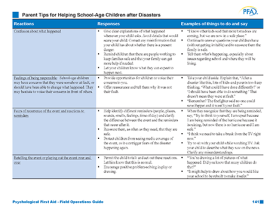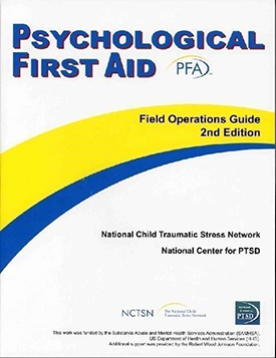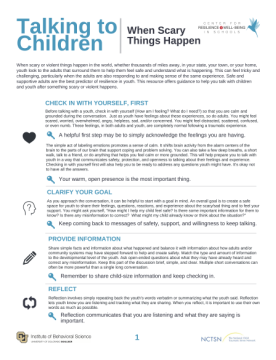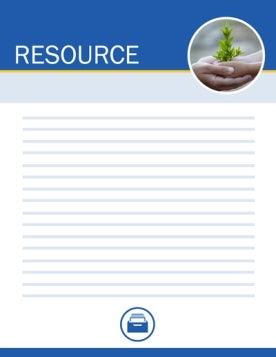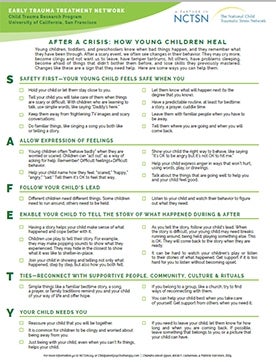A windstorm is a storm with high winds or violent gusts that are strong enough to cause at least some damage to trees and buildings. Windstorms usually involve wind speeds that exceed 34 mph. Damage from windstorms occurs from gusts, or short bursts of high-speed winds, as well as longer periods of stronger, sustained winds. Windstorms can take several forms, including downbursts, derechos, haboobs, and dust storms. When windstorms carry fine particles, as in a dust storm, they can reduce visibility quickly and may lead to accidents and massive car and truck pile-ups. Dangerous wind gusts are very difficult to predict and can occur without warning, so thunderstorm or dust storm warnings may be the only warning that they might occur.
Being prepared beforehand is the best way to help children and family members stay safe after a windstorm. To improve their preparedness, families should:
- Identify the safest room in their home to shelter in place. Families should plan to go to a storm cellar, basement, or the lowest building level during a severe windstorm. If there is no basement, encourage them to go to an inside room without windows, like a closet or bathroom. It is best to stay away from windows, corners, or outside walls.
- Understand the different weather alerts related to windstorms. Because windstorms take many forms, there are several advisories and warnings of which families should be aware. It is also important to pay attention to warnings for severe thunderstorms, as these storms may produce downbursts and derechos that usually do not have their own warnings. These alerts include:
- Severe Thunderstorm Watch: Issued when conditions are favorable for severe storms (wind gusts of 58 mph or more or ¾ inch diameter hail or larger). People in the watch area should monitor the sky and stay tuned to know when warnings are issued.
- Severe Thunderstorm Warning: Issued when large hail and/or wind gusts of 58 mph or greater are imminent. People in the warning are should take shelter in a substantial building or in a vehicle with the windows closed.
- Blowing Dust Advisory: Issued when blowing dust is expected to reduce visibility to between ¼ and 1 mile, generally with winds of 25 mph or greater. People should monitor for updates and exercise caution for outdoor activities and driving.
- Dust Storm Warning: Issued when blowing dust is expected to reduce visibility frequently to ¼ mile or less, generally with winds of 25 mph or more. People should avoid travel in the area until the dust clears, and those with respiratory problems should prepare to stay indoors until the storm fully passes.
- Assemble an emergency supply kit. Families should have access to enough water, food, and other emergency supplies. They should also gather copies of important documents, a radio with batteries as needed for weather updates, and supplies for pets. For a complete checklist of what to include, review the family preparedness plan.
- Make a family communication plan. Keep important contact information easily accessible and know who to contact if separated from one another. Babysitters and caregivers should also have this information. To develop their plan, families can fill out the preparedness wallet card.
- Plan for children’s needs. Families should give children factual information about windstorms in simple terms. Parents can also include children in preparedness activities. The mobile app Help Kids Cope provides parents with ideas about how to talk with children of different developmental levels.
Knowing what to do during a windstorm can help families feel more in control and take steps to increase their safety. Consider the following:
During a severe thunderstorm, families should:
- Take shelter in a sturdy building. Families should move to their identified safe place and avoid isolated sheds or small structures in open areas. Stay away from windows and doors, and stay off porches. They shouldn’t lie on concrete floors or lean against concrete walls. Have them take their pet to the same safe place.
- Avoid dangerous hazards when outside. During a thunderstorm, families should avoid natural lightning rods such as a tall, isolated tree in an open area. It is also safer to avoid hilltops, open fields, the beach, or a boat on the water.
- Extend emergency supplies. If there is a concern about losing power, families should fill up tubs or jugs with water and keep mobile devices charged.
During a dust storm, families should:
- Take shelter immediately. If outside, families should move indoors with their pets as soon as possible. To reduce the impact of dust, cover eyes, nose, and mouth using a bandana, scarf, shirt, or hands. If having to remain outside, families should stay low and cover up.
- Practice safe driving. Encourage families to pull off the roadway, turn off all car lights, set the air conditioner to recycled air, and stay in the vehicle with seatbelts buckled until the storm passes.
- Monitor children for respiratory issues. Symptoms of dust exposure include wheezing, shortness of breath, sore throats, flu-like aches and pains, and fatigue. Seek medical attention when it is safe if children develop any of these symptoms.
To address children’s reactions during a windstorm, parents and caregivers can:
- Model calm behavior. Children may mirror the reactions of adults around them and will learn ideas for how to take care of themselves from what parents and caregivers do.
- Provide simple but accurate information in a quiet, steady voice.
- Encourage comforting or distracting activities. Children may benefit from doing slow breathing to calm their bodies, having a stuffed animal or blanket to hold, or engaging in simple activities to keep distracted when sheltering inside. For additional ideas, view these handouts.
- Practice their own self-care. Parents and caregivers may benefit from finding opportunities to take a moment for themselves, express their feelings, acknowledge that it is a scary situation, and engage in a coping strategy.
After a windstorm, most families will adjust and be able to return to their normal routines rather quickly. Most children will demonstrate resilience. Some children may react more strongly, however, if their homes or schools experienced damage. Parents and caregivers can support children by modeling effective problem-solving, maintaining consistent daily routines, and providing accurate information about repairs and changes the family or community will need to make after the storm. Those children who have experienced a loss of a loved one or pet will need additional grief support to help them adjust.
Below are resources to support children, families, and communities to recover after windstorms.

